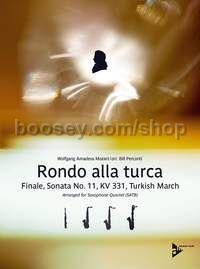Rondo alla turca KV 331 - 4 saxophones (SATBar) (score & parts)
Rondo alla turca KV 331 - 4 saxophones (SATBar) (score & parts)
* Estimated price converted from UK retail price
With the invention of the saxophone in the early 1840’s, transcriptions are useful to present day saxophonists who wish to perform music of various styles and composers, and are thus an important part of the saxophone repertoire. One source of music to transcribe is the vast piano repertoire of the Classical era. Mozart’s Finale from Sonata No. 11, KV 331, also known as Rondo alla Turca, is one of his most recognized works. This tuneful, lively work was composed in the late 1770’s, and since then has been transcribed for many ensembles. Two objectives were in mind while transcribing the Rondo alla Turca. One was to produce a relatively clean manuscript with a minimum of articulation and dynamic markings so as to allow interpretation by the performers. Such markings found here are provided only as suggestions. Secondly, rather than featuring just the solo soprano saxophone, the melodies were given to other parts as well.




